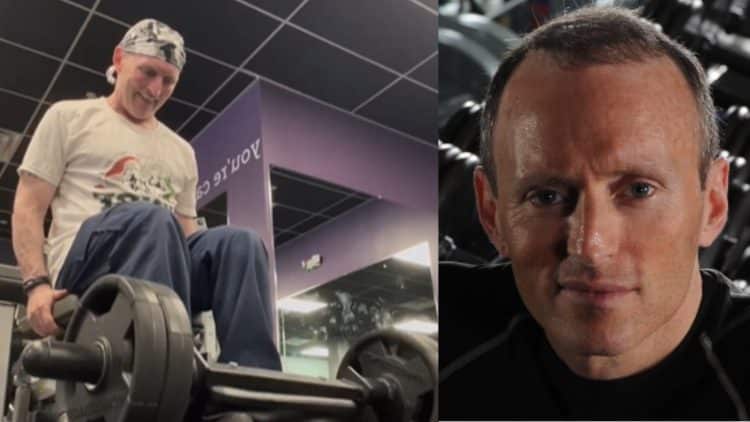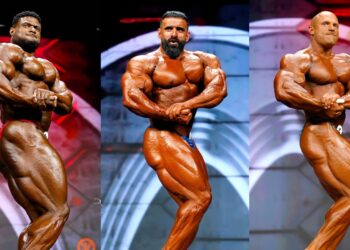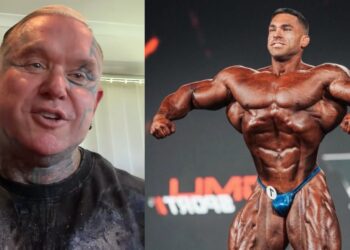Dr. Brad Schoenfeld is revered in the fitness community for his dedication to the science behind muscle building. In a special collaboration with Dr. Rhonda Patrick, Schoenfeld opened up on how to achieve hypertrophy without lifting heavy and going to failure.
With decades of experience, Dr. Brad Schoenfeld’s evidence-based approach to exercise science has turned him into a star. Known as ‘The Hypertrophy Specialist,’ Schoenfeld’s contributions and insight are not only easy to understand but provide valuable knowledge for anyone seeking gains.
Schoenfeld has tackled several burning questions in the fitness world, like the validity of the anabolic window, time-restricted eating, and protein intake for bodybuilders. He boasts over 347,000 YouTube subscribers and never shies away from enlightening his viewers on recent information he has curated through thousands of research papers and scientific studies.
Dr. Brad Schoenfeld on Lighter vs Heavier Loads and If Going to Failure is Essential to Hypertrophy
According to Schoenfeld, ‘compelling literature’ has suggested that you can gain similar amounts of muscle regardless of the loading capacity (weight being lifted). He added that there might be benefits to light loads for type 1 fibers and heavy loads for type 2 fibers, but specified that his confidence in those studies is ‘modest at best.’
Level Up Your Fitness: Join our 💪 strong community in Fitness Volt Newsletter. Get daily inspiration, expert-backed workouts, nutrition tips, the latest in strength sports, and the support you need to reach your goals. Subscribe for free!
“The literature is now compellingly showed – I just there’s so much literature on the topic our lab has done quite a bit of research as well as many others and it shows that you can gain muscle similar amounts of muscle regardless of the loading across a wide range of loading spectrums up to 30 to even 40 repetitions which is a long, that’s a long set,” said Dr. Brad Schoenfeld.
“This is still equivocal, there may be some muscle fiber-type specific benefits to doing light loads for type one fibers and type two fibers for heavy loads. If you’re asking me my confidence in that literature, it’s modest at best. But I can’t rule out that that would be the case but when you’re looking at MRI data or ultrasound which we’ve used extensively, it really shows no difference.”
He warned that heavy lifting could be problematic for those who are training through injuries, especially for the older demographic.
“If you’re training through injuries, heavy loading can be contraindicated and also particularly for the older individuals because joint-related issues as you know as people get older they get osteoarthritis and other joint-related issues where heavy loading can be very uncomfortable for them and perhaps debilitating.”
However, if you are lifting light and aren’t adequately challenging your muscles, Schoenfeld says you won’t achieve gains.
“The caveat to this is the lighter loads have to be taken with a high degree of effort. If you do not extensively challenge your muscles meaning the last few reps are difficult to complete, you’re not going to achieve gains.”
Concerning lighter loads, Schoenfeld underlined that if the set was easy, your body hasn’t been challenged enough to make strength and muscle-building adaptations.
“With lighter loads, the first number of repetitions are very easy to complete. If it’s easy to complete you’re really not doing much for challenging. This goes back to a survival mechanism. The reason the body I think this is important, the reason the body adapts to strength training is survival. That’s the reason the body adapts to anything is through a survival mechanism.”
“If you are not challenging it in a way that it is accustomed to being challenged, it has no impetus to adapt. The reason you will get these adaptations in strength, power, hypertrophy, muscle endurance, bone density, etc, is because the muscles and bones, etc, the tendons, ligaments are being challenged beyond their present capacity.”
Dr. Rhonda Patrick prefers a lighter weight with higher volume.
“I’ve done both and I do find for me, I like doing the lighter lifting and more reps versus heavier and fewer reps. I also noticed I’m less likely to injure my wrist,” adds Patrick.
While many bodybuilders, including the late Mike Mentzer, Arthur Jones, and former six-time Mr. Olympia Dorian Yates were major proponents of going to failure, Schoenfeld explains that the evidence doesn’t support it as the only way to build muscle.
“Failure, the operational definition would be the inability to perform another repetition with proper form. We carried out a meta-analysis recently on this topic. The bottom line is that and that’s the go hard or go home philosophy, the bodybuilding mentality, go hard or go home, every set needs to be taken to failure.”
The evidence does not indicate that’s the case. Certainly, you need to train with a high amount of effort but to take or certainly take every set to failure is not only, does it not show any benefit for hypertrophy, it actually showed a small detriment for strength.”
That being said, Schoenfeld refused to dismiss the idea of someone gaining muscle by routinely going to failure on each set.
“There’s some limitations to that research. Does that mean if you train to failure you won’t maximize your strength? I’m not necessarily on board with that but that is what our results show.
I would also not dismiss the fact that for very high level, let’s say you’re very close to your genetic ceiling it might make the need to go to failure on some of the sets more relevant, beneficial, we don’t have – this is purely speculative on my end.”
Aside from Dr. Schoenfeld and Dr. Patrick, Mike Israetel, an exercise scientist who holds his doctorate in sports psychology, has also examined a handful of topics related to muscle building. Most notably, he revealed his four-factor checklist’ for effective rest periods and ideal warm-up methods.
With insight backed by scientific data, hearing Dr. Schoenfeld’s opinions on fitness provides invaluable guidance in training optimization. Schoenfeld asserts that achieving hypertrophy is possible whether utilizing lighter weights or heavier loads, as long as the training sufficiently challenges the muscles.
RELATED: Exercise Scientist Reveals Strategy for Developing Unstoppable Gym Motivation









